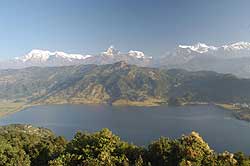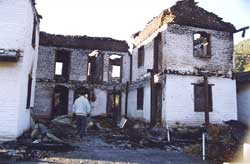 Dilapidated signboards and checkposts that are boarded up are signs that the Maoist insurgency is taking its toll on once-flourishing projects like the Annapurna Conservation Area Project (ACAP). Nepal's eco-tourism success story and a powerful example of using tourism income for local development and environmental conservation, ACAP has been targetted by Maoists and its activities are a shadow of its former self.
Dilapidated signboards and checkposts that are boarded up are signs that the Maoist insurgency is taking its toll on once-flourishing projects like the Annapurna Conservation Area Project (ACAP). Nepal's eco-tourism success story and a powerful example of using tourism income for local development and environmental conservation, ACAP has been targetted by Maoists and its activities are a shadow of its former self.
Born and raised in Ghandruk, Prakash Bahadur Gurung is confident his village is ready to take full responsibility for the project. His father, Min Bahadur Gurung, was instrumental in convincing locals of the benefits of joining hands with ACAP. His generation has witnessed the positive social and economic changes. But with ACAP's village offices closed, he feels the pace of the project slowing and is concerned about the future. He is actively working to help local conservation committees to manage the project, but faces a stumbling block of national proportions: "Without peace and security, nothing can be done."
Trouble started three years ago, when Maoists made a bonfire of official papers at Lwang. In 2001, when the emergency was declared, NGOs were targeted but all of ACAP's offices were operational until September this year. "After the peace talks broke down, the Maoists came to Ghandruk and destroyed the ACAP office, telling staff not to return. We had to close all our offices in the southern belt," says Gehendra Gurung at ACAP's office in Pokhara.
Even so, Gurung assures us that the project is on track elsewhere. Staff are working on handing conservation activities to local communities to manage. Villagers mobilise themselves, decide what needs to be done, and put up the suggestions to ACAP. Once the activities are approved, locals participate in implementing them. Since phone lines have been cut off in many parts, villagers walk down to the Pokhara office for financial and technical support and training. Wherever possible, ACAP uses local knowledge from staff stationed in the area.
ACAP began in 1985 when King Birendra, after a visit to the western development region, ordered an investigation into the impact of the more than 14,000 trekkers on the area. Poorly managed tourism had exceeded the land's carrying capacity through overpopulation, deforestation, pollution of the trails and a severe threat to the biodiversity of the unique ecological wealth of the Annapurnas.
A three member team, including Chandra Gurung, currently the country representative for World Wide Fund Nepal, walked for nearly three months from Pokhara to Upper Mustang, over Thorung La and down through Manang to study what could be done. They found traditional systems of natural resource management prevailed in the region, but most villagers were against declaring the area a national park.
Gurung recalls: "They were aware that the Sherpa experience in the Sagarmatha had not been positive. A national park, by definition, excludes permanent settlements and 80 percent of their budget would go to military protection. Wildlife reserves, too, had their own set of problems."
Ghandruk used to be well-managed by retired Gurkhas who kept their villages tidy and the trails well-maintained. By 1985, when Gurung's investigation team arrived, trekking pressure had taken its toll: trails were dilapidated and the villages had become littered. From the average $3 earned from a tourist per day, 20 cents stayed in the village, the rest seeped out to Pokhara and Kathmandu.
Up the trail, Ghodepani used to be one of the largest rhododendron forests in Nepal. By 1985, many of the stately trees along the trail to the pass had been chopped down for firewood and for constructing tea sheds and lodges. Initially, ACAP had difficulties gaining trust, especially getting people to relocate, a task that took three years.
 But, working with local communities, the project managed to convince them that they could use ACAP's seed money for community development and to protect, manage and use their natural resources. The 100,000 people from 10 ethnic groups who lived and farmed in the region had to be convinced that this was a viable plan. It took another year-and-a-half to formulate a new concept of using tourism fees to be recycled back to the villages and get it approved by locals. Then approval finally came from the government in Kathmandu.
But, working with local communities, the project managed to convince them that they could use ACAP's seed money for community development and to protect, manage and use their natural resources. The 100,000 people from 10 ethnic groups who lived and farmed in the region had to be convinced that this was a viable plan. It took another year-and-a-half to formulate a new concept of using tourism fees to be recycled back to the villages and get it approved by locals. Then approval finally came from the government in Kathmandu.
The daunting task of managing the project, with an initial funding of $1 million for the first five years from WWF, fell upon the King Mahendra Trust for Nature Conservation (KMTNC). In December 1986, KMTNC set up the project
in Ghandruk and it was off and running.
The project had a four-point agenda: peoples' participation, sustainability, hiring and training of local project managers and finally, ACAP was to phase out of the area, handing over management to local communities. Gurung recalls the hard struggle to make the plan work, but in the end it did. He says: "Now ACAP is known worldwide as a project initiated and implemented by Nepalis. It has become a model for protected areas and is the right approach given the political situation. Just look, community projects are not attacked (by Maoists). The power of local communities has manifested itself." Today, ACAP surpasses Sagarmatha National Park as the most popular tourist destination in the kingdom and has been able to sustain the influx with minimum impact on the environment.
Executive officer at KMTNC, Ganga Jung Thapa makes it his business to know how the trust's projects are fairing. "The people cannot conserve on an empty stomach so conservation and development must be complementary. This way, Ghandruk showed other villages that they could increase income and improve welfare." In 1992, when Upper Mustang opened up for limited tourism, the government included it in ACAP.
ACAP's work has included natural resource management, alternative energy, cultural conservation, livestock and agriculture, repair of temples and gompas, research on flora and fauna. Thapa regards developing communities' capacity to manage the conservation area as critical.
In 1996, the 55 VDCs in the project region each had a Conservation Area Management Committee which worked directly with ACAP. By ensuring that the VDC chairman was an ex-official of the committee, the two groups were able to work on the same level. The focus then shifted to training committee members in office management and project implementation. ACAP took on the role of facilitator since the locals involved were in a better position to implement activities while reaching more people.
ACAP recently began handing over the responsibility of the conservation area to local communities and the project hopes to use the next ten years to extend this process and build local capacity for environmental management. But this process is facing delays because of the insurgency. There are also grumblings in some ACAP areas that the promised recycling of 40 percent of tourist fees to local areas has not happened, and many villagers don't like ACAP restrictions on firewood, grazing, plastic water bottle use and other measures.
We asked Chandra Gurung, who is from the village of Siklis, north of Pokhara, what he would do differently. He is still very attached to ACAP and says he would start with a baseline database and measure change. "ACAP is a milestone in conservation in Nepal, if it goes, the impact will be huge. Local communities must now carry on the achievements of the last two decades."


